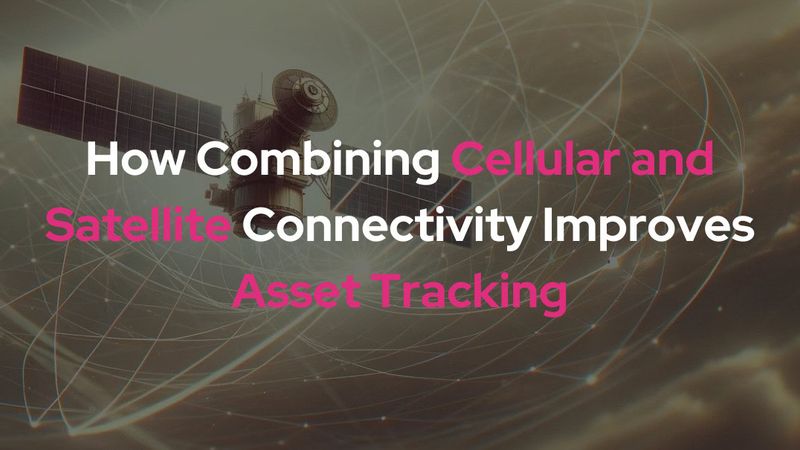How Combining Cellular and Satellite Connectivity Improves Asset Tracking
The advent of cellular IoT connectivity revolutionized the way businesses were able to track assets and fleets around the world, and the exponential growth of connected devices continues at a rapid pace. The GSMA reports that between 2020 and 2022, the number of LTE-M networks increased nearly 30%.

The advent of cellular IoT connectivity revolutionized the way businesses were able to track assets and fleets around the world, and the exponential growth of connected devices continues at a rapid pace. The GSMA reports that between 2020 and 2022, the number of LTE-M networks increased nearly 30%. This increase demonstrates how fundamental connectivity has become to support the way businesses manage their fleets.
But what happens when those fleets move outside the boundaries of cellular services? How can businesses circumvent issues when assets are in remote locations? Here we’ll discuss the benefits of satellite asset tracking, and how using satellite connectivity along with cellular should become standard for the future success of asset management enterprises.
Combining Satellite and Cellular Connectivity for More Effective Asset Tracking
The ability to track fleets on the move and on the ground in areas where cellular connectivity is reliable and readily available has significantly improved in recent years. But as companies expand their global presence, sending assets or fleets across oceans or into remote areas, cellular connectivity is no longer a viable or singular option for asset monitoring. In the shipping industry, for example, cellular connectivity allows companies to check ship location statuses from port to port, but not in between.
Satellite tracking bridges the gap when ships are traveling across oceans, allowing for more efficient and effective fleet tracking. And while satellite services were once prohibitively expensive, demand has pushed prices down, and more satellite providers make the cellular/satellite connection financially viable. Now, the use of cellular and satellite networks offers a perfect balance between performance and price.
Plus, when devices are on the move in remote locations—where cell towers are scarce or non-existent—satellite connectivity becomes the only reliable method to track assets and fleets.
When The Assets You’re Tracking are People: NEYOS Otrac
There are recognizable use cases for a combined cellular/satellite asset tracking—container shipping, as we’ve mentioned, and other supply chain logistics. But there are other use cases—ones in which the devices that need to be tracked are people.
NEYOS, a manufacturer of a portable geolocation beacon, was founded following a life-threatening incident in which its co-founder was unable to reach emergency services while located on a mountain. Based on that experience, they developed the NEYOS Otrac, the first satellite and cellular geolocation beacon that allows the tracking of remote sporting activities, like ultra-marathons. And this tracker has become available at a time when ultra-marathoning is rapidly growing. Ultra marathon participation has vastly increased over the years—a staggering 345% in the last decade. As more people become interested in this activity, tracking participants becomes even more essential to ensure runner safety.
NEYOS provides sporting event organizers the Otrac and a subscription connectivity plan that offers 4G cellular and satellite tracking ideal for monitoring in remote locations. Those tracking beacons are handed out to runners as part of their marathon safety protocol. If a runner participating in an organization’s event deviates from the planned course or experiences an emergency, the event organizers are immediately alerted through the Otrac security beacon and help can be dispatched promptly.
Other Industries Benefiting from Using Cellular/Satellite Connectivity Combination
The NEYOS beacon use case applies not only to ultra-marathoning, but also to many other remote sporting events, like sailing competitions, remote hiking and cycling, and rally raids. And it also benefits many more emerging industries thanks to its flexible use of both cellular and satellite connectivity. Another instance in which people need to be monitored is when companies dispatch lone workers to remote areas. Similar to sporting event participant tracking, using a monitoring device in conjunction with satellite connectivity gives businesses peace of mind that their employees can make emergency contact using their tracking device. Other sporting activities, like sailing competitions, or agricultural goods tracking—where food is monitored from farm, to port, to ship, then to store—also require both remote satellite and cellular services.
Cellular/Satellite Tracking for Asset Management
Businesses have benefited from asset tracking and management thanks to cellular IoT connectivity, but they need to look to the future in which assets are moving across areas without cell towers. Devices like the NEYOS Otrac, combined with cellular and satellite services provided by Monogoto and Skylo, ensure a smooth transition into the future of asset management.
Scale and Innovate with Monogoto
With Monogoto’s cloud best practices, developers and innovators can start small, with access to all APIs immediately, and scale with a truly global cloud offering. Secure, seamless connectivity across cellular, satellite, and private LTE/5G networks forms the foundation of the future of asset tracking. As the industry evolves, embracing connectivity advancements is key to unlocking new opportunities for growth. Monogoto stands at the forefront of this journey, offering cutting-edge connectivity solutions and developer tools that empower enterprises to innovate like never before. Book a demo with Monogoto today and take the first step towards a revolutionary experience.